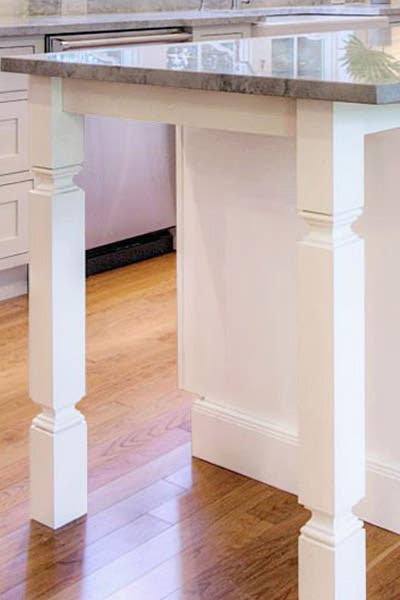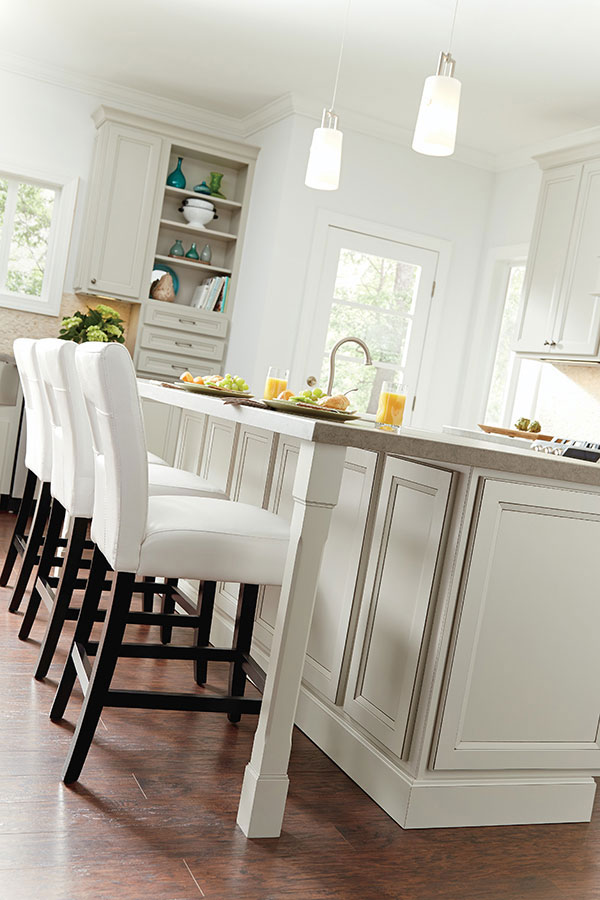Transform Any Type Of Kitchen Area with Gorgeous Legs For Kitchen Island Selections
Transform Any Type Of Kitchen Area with Gorgeous Legs For Kitchen Island Selections
Blog Article
Trick Considerations for Discovering the Best Legs For Kitchen Island for Your Style
When choosing the suitable legs for your kitchen area island, a number of key considerations enter play that can considerably affect both capability and looks. The selection of height, product, and style should align with your total kitchen area design to guarantee a harmonious appearance. Furthermore, security and upkeep demands are critical for lasting use and ease of care. Understanding these variables can boost your kitchen's practicality and visual allure, however the subtleties of each factor to consider can usually be ignored. What effects might these selections carry your kitchen's overall environment?
Determine Your Style Preference
When choosing the optimal legs for your kitchen island,Identifying your style choice is vital. The legs of your kitchen island not only offer a functional objective yet likewise contribute considerably to the overall visual of the room. Recognizing your layout style-- be it modern-day, rustic, typical, or commercial-- is crucial.
For a modern-day kitchen area, consider streamlined, minimalistic legs that enhance open areas and clean lines. In contrast, a rustic setting might take advantage of more robust, farmhouse-style legs made of recovered products. Typical kitchen areas usually prefer turned or luxuriant legs, which can add a touch of elegance and elegance. At the same time, an industrial visual could ask for metal legs that stress a raw, unfinished look.
Furthermore, take into consideration the elevation and proportion of the legs in relationship to the island's surface area. Ultimately, your design preference will influence not only the option of legs yet likewise the overall consistency of your kitchen area's layout.
Select the Right Material
Picking the right material for your kitchen area island legs is essential in making sure both longevity and aesthetic allure. Numerous materials offer distinct benefits, and the selection usually mirrors your style preferences and practical demands.
Timber is a popular option, providing heat and flexibility. It can be stained or painted to match your kitchen area decoration, making it versatile to different styles, from rustic to contemporary. Wood may need normal maintenance to maintain its appearance and stability.

If you seek an one-of-a-kind touch, take into consideration acrylic or glass products. They can develop an illusion of area and agility in your kitchen area, making them an exceptional option for smaller areas - Legs For Kitchen Island. These alternatives may need cautious handling and upkeep to stay clear of scrapes.
Ultimately, the product you select need to line up with your cooking area's overall design, making sure that the legs offer both practical and ornamental functions.
Consider Height and Proportions
When creating a kitchen area island, height and proportions play an important role in guaranteeing functionality and comfort,. The common elevation for a cooking area island normally varies from 36 to 42 inches, aligning with traditional counter elevations or bar heights, specifically. This measurement is crucial for harmonizing with bordering feceses and countertops, allowing ease of usage throughout dish prep work and social interactions.
Furthermore, the island's proportions must complement the general kitchen area design. A well-proportioned island should not bewilder the space; rather, it needs to develop a balanced aesthetic. Consider the ratio in between the island's size and length, guaranteeing it gives sufficient area without crowding the kitchen. A basic standard is to maintain a size of 24 to 48 inches, helping with activity and ease of access.
Moreover, the elevation of the legs or base can influence the visual allure and performance. Taller legs might provide an extra contemporary, airy feeling, while shorter ones can stimulate a conventional, grounded look. Ultimately, very carefully taking into consideration height and percentages will certainly cause a kitchen area island that is both functionally effective and visually enticing, improving the general style of the room.
Assess Stability and Toughness
A kitchen island's legs should not only complement its elevation and proportions but additionally provide appropriate security and toughness to support day-to-day tasks. The legs are important to the total performance of the island, as they birth the weight of the kitchen counter and any type of extra loads, such as devices or cooking tasks.
When assessing security, it is crucial to take into consideration the leg style and material. Durable steel or strong hardwood legs usually use superior strength contrasted to lighter materials like engineered wood or plastic. Furthermore, a larger base directory can enhance stability, decreasing the danger of tipping or tottering throughout use.
Resilience is equally crucial; the legs should stand up to wear and tear from day-to-day usage. Consider finishes that shield versus scrapes, damages, and moisture, particularly in a cooking area setting. Evaluate the top quality of building and construction, such as joints and fastenings, which can substantially influence the legs' lasting performance.
Inevitably, investing in well-crafted legs that focus on stability and resilience will certainly ensure your kitchen island stays a trustworthy workspace for several years ahead, boosting your cooking experiences while preserving visual charm.
Consider Upkeep and Treatment
Maintenance and treatment are essential considerations for ensuring the durability and efficiency of kitchen island legs. When selecting legs, it is vital to assess the products made use of, as different options need differing levels of upkeep. For instance, wood legs might need regular refinishing or sealing to avoid moisture damage and scrapes, while metal legs may require normal brightening to maintain their sparkle and protect against corrosion.
Moreover, the coating put on the legs can influence upkeep needs. A high-gloss finish may be easier to clean but might show fingerprints and scratches extra conveniently than a matte surface. It is suggested to select materials and finishes that complement your lifestyle; for instance, if you often host celebrations, select long lasting materials that can hold up against damage.
Additionally, take into consideration the hop over to here cleaning procedure associated with preserving these legs. Smooth surface areas commonly call for marginal initiative, while complex styles may collect dirt and gunk, necessitating even more labor-intensive cleansing methods. Legs For Kitchen Island. Ultimately, considering the maintenance and care needed for your picked cooking area island legs will not only boost their aesthetic charm yet additionally ensure their useful integrity over time
Final Thought
Finally, picking the optimal legs for a kitchen area island demands i was reading this cautious factor to consider of different factors, consisting of layout style, product choice, upkeep, stability, and height. Each aspect plays an important role in guaranteeing that the legs not just enhance the aesthetic allure of the kitchen yet also offer the necessary assistance and resilience for day-to-day usage. A well-informed choice will ultimately add to a useful and visually pleasing kitchen environment.
The legs of your kitchen island not only offer a useful objective but also contribute significantly to the overall visual of the room.Upkeep and treatment are crucial considerations for making sure the durability and performance of kitchen area island legs. Wooden legs might require regular refinishing or sealing to prevent moisture damage and scratches, while steel legs may need routine polishing to keep their shine and stop rust.
Eventually, factoring in the maintenance and care required for your selected kitchen island legs will certainly not just enhance their visual appeal yet likewise guarantee their practical honesty over time.

Report this page